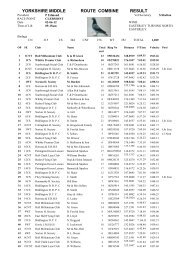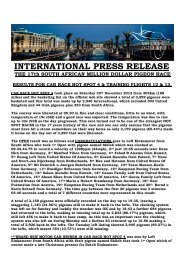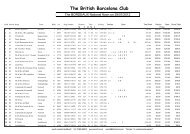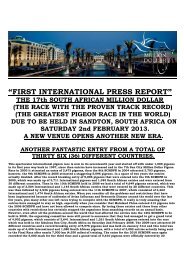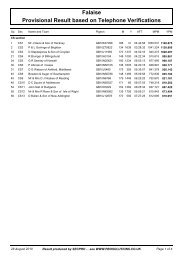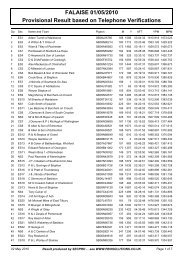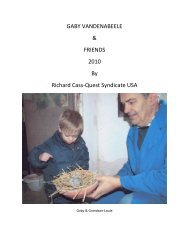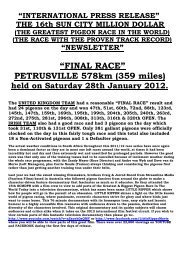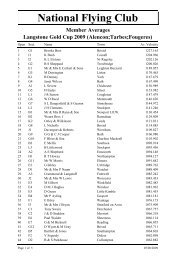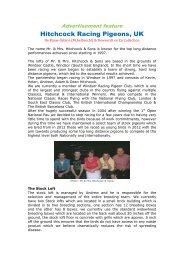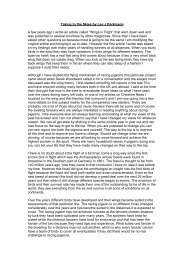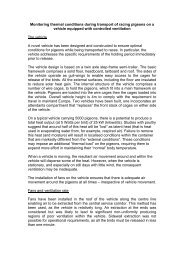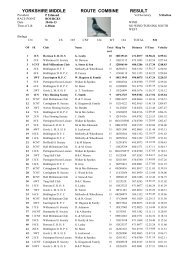Create successful ePaper yourself
Turn your PDF publications into a flip-book with our unique Google optimized e-Paper software.
MONTH BY MONTH<br />
with Chris<br />
Champion “Tracey’s Red” winner of the N.W.C.C.<br />
Hall of Fame and over £5,000 in his racing career,<br />
for Chris Knowles of Woodley, Stockport.<br />
<strong>April</strong> -- Aphrodite's month<br />
Aphrodite is the Greek goddess of love and beauty. She is identified with the Roman goddess<br />
Venus. Old English <strong>April</strong>(is), Latin <strong>April</strong>is, <strong>April</strong>is had 30 days, until Numa when it had 29 days, with<br />
Julius Caesar it became 30 days long.<br />
<strong>April</strong> - The month when exercise and feeding become the subjects of focus, following the months where<br />
concentration has been on health, feather growth and the rearing of future champions.<br />
Fitness - What do we really mean when we talk about fitness in our pigeons<br />
I have long thought that is one of the most misleading words in the pigeon game, along with “Form” and<br />
“Champion”. Most fanciers I think are referring to a physical state which is measured in how long pigeons<br />
exercise for or how long they disappear for when let out for exercise or even whether cocks are clapping<br />
up and down on a constant basis when out and flying as individuals and not in a bunch.<br />
It is worth looking at Dictionary definitions of the word “Fitness” :- “capability of the body of distributing<br />
inhaled oxygen to muscle tissue during increased physical effort”. Health is defined as “The general<br />
condition of the body or mind with reference to soundness and vigor, good health, poor health”. The<br />
interesting thing is that we now have some tangibles to look at, such as distribution of oxygen to<br />
muscle tissue during increased exercise and condition of body or mind. If you read the works of Ad<br />
Schaerlackens, you will know that he refers to “conditioning” pigeons, a reference to the mental state of<br />
pigeons and their minds and attitude with regards to trapping etc. I believe that to be successful in the<br />
game today you must pay attention to the mental state of your pigeons and that their confidence is just as<br />
important as any other factor if you wish to be successful in competition.<br />
The Sun Rise & Sun Set times for <strong>April</strong> 2009 in my area.<br />
Length Of Day Day RiseTime SetTime<br />
14.141 Hrs 18/4/2009 5.094 19.235<br />
14.593 Hrs 25/4/2009 4.846 19.439<br />
14.906 Hrs 30/4/2009 4.677 19.583
As for the physical side of fitness, I think that it is very important to allow sufficient time prior to road<br />
training, to get the birds fit enough for that road work and then again enough time for fitness for racing. My<br />
experiences over the years have brought me to a conclusion that it takes around eight weeks at the start of<br />
a season, to get the pigeon adequately prepared for racing. Obviously your chosen start date comes into<br />
play for your preparation and if you want to start from the first race, then you have to make the best you<br />
can of the very changeable weather that we get in February, March and <strong>April</strong>, let alone the lack of<br />
adequate hours of daylight. The start and finish dates of our racing seasons are something that I would<br />
change if I could. I have tried over the years by submitting propositions to change race programs but all in<br />
vain I am afraid. It would appear that the majority nowadays don’t wish to consider the difficulties of the<br />
man who has to go out to work or more importantly to me, what is in the best interest of the pigeon.<br />
However, in the world of democratic rule, the majority hold sway and so you have to accept it or plan your<br />
season to suit yourself. My choice is the latter. Just out of interest, my view is that we should begin Old Bird<br />
club racing on the last Saturday of <strong>April</strong> and that it should continue until last Saturday in August, with the<br />
last four races being combined Old and Young bird races. The young bird season would be from end of<br />
July to end of September with the final two races from a distance suitable for summer bred youngsters.<br />
This would allow fanciers to stop those young birds that have already flown long hard races and need to<br />
begin their moult in earnest.<br />
Having digressed slightly, I will get back to the physical preparation track that I follow. I should first make it<br />
clear that my thoughts are based on an assumption that the birds have been confined during winter<br />
months, as stated in earlier articles, due to the problems we now experience with hawks. The exercise can<br />
obviously only begin when the birds are in good health, which must allow some recovery time if they have<br />
reared youngsters and may also have become widows/widowers. I begin the exercise periods with once<br />
per day for a week or so and then increase to twice per day and in doing so gradually increase the flight<br />
times in relation to feed and body weight. This way takes a little longer than what can be achieved but I<br />
think it is better for the pigeons and by reaching a fitness level this way you are limiting any unnecessary<br />
stress levels. I would like to see some statistics on the number of good pigeons that are injured or lost in<br />
the first few weeks of training and racing each season. I know in the past, that I have made such mistakes!<br />
My target is to get the birds to a level where they are exercising well for at least forty five minutes twice per<br />
day, before I consider training. When I reach this level, I drop my hens back to exercising once per day and<br />
a toss at around 20 miles Mon/Tues/Thurs on a communal training facility. The cocks stay at twice per day<br />
exercise except on days where I train them myself with tosses up to 40 miles.<br />
This picture, taken of one of my old cocks bathing on the morning of basketing for his first race of the<br />
season, is an excellent illustration of one of the most important contributors to health and rest.
The next aspect of management with regards to maintaining health and fitness for racing, can be<br />
somewhat controversial, it is that of medication during the racing season. Discussions and in some cases<br />
arguments have rolled on over the years with regards to the pros and cons of what and when to give<br />
certain things to pigeons when racing. I doubt whether that will ever change in my time and I am not sure<br />
that there is a “perfect” answer to the debate. I will share with you, my view and my thoughts and try to<br />
explain my logic for what I personally do. Firstly I must say that my views are based on information<br />
gathered over many years via what I consider to be top drawer fanciers and top drawer pigeon vets. Over<br />
recent years, the Internet has played a big part in my quest for knowledge and information.<br />
I think the first thing to consider is, what risks to health do your pigeons face when confined to race baskets<br />
with other pigeons Secondly,do ALL other fanciers keep their pigeons in the health that you require for<br />
yours and if not, is it likely that your pigeons could be aversely affected. With these factors in mind, I take<br />
what I consider to be reasonable steps, based on veterinary advise, to provide what I believe to be an<br />
adequate program for disinfection. My practice for Old Bird differs slightly from Old Birds to Young Birds, so<br />
I will cover the YB one in a later article. The main enemies as far as I am concerned are as follows, canker,<br />
bacterial infections and infections of the upper respiratory tract and head. Whilst in the race panniers, our<br />
pigeons are not only subjected to other pigeons which may not be 100% healthy but also stress and in<br />
some instances environmental conditions such as temperature and humidity which can and do lead to<br />
dehydration.<br />
To illustrate my personal approach to my concerns above, I will describe what I do during the week in race<br />
season. Starting on a Saturday on return from the race, the birds get a drink of fresh water and a little to eat<br />
of something that they like and is easy to digest. In the evening they get electrolytes in their water and a<br />
light feed. Sunday they are given either a treatment for canker (over 2 days) or a disinfectant (Virkon) for a<br />
day and a half. I alternate these two each week. Every 4 weeks on Wednesday, I give the birds a product<br />
to support their gut flora and for this I prefer Flight Path. Every 2 weeks on the day before basketing, I give<br />
a cure for URT and Ornithosis. I am careful to watch this during periods of cold and damp weather.<br />
Obviously from time to time I may decide to deviate from the above slightly but in combination with lots of<br />
hard work, methodical feeding and rest, this is how I prepare my pigeons during racing.<br />
Not just a bath, the first important trigger activity to signal that race day and “REWARD” is due!<br />
As seems to be the seasonal norm. nowadays, the race program has begun with a mixture of East winds<br />
and blow homes! Not exactly the ideal conditions for pigeons that you wish to bring into condition for the<br />
May and June Nationals but as usual we are faced with the dilemma of take a chance or miss the boat.<br />
Well this season I have decided to leave the yearling cocks at home and continue their training until there is<br />
some sign of half decent and consistent weather on the horizon. When I think back over the years, one of<br />
the best pigeons that I ever raced, was June hatched, never trained as a YB, had three 100 mile races in<br />
May as a yearling and went on to win 2 x 1st Section National at 535 miles winning 3rd Open and 12th<br />
Open and 5th Section 15th Open National at 428 miles. He was also awarded Europigeon’s Ace <strong>Pigeon</strong><br />
award calculated using a co-efficient from National races over two seasons. This pigeon was “Highview<br />
Northern Pride” which was later sold top the late Brian Long and which Brian told me was responsible for<br />
some of his best distance performances. So it goes to show, if you don’t burn the candle at both ends, the<br />
light can burn just that bit brighter!
Balance is the key, getting the mix of exercise, training, rest, mental conditioning and feeding all in<br />
proportion to one another and mother nature will provide the sun and oxygen to complete the formula for<br />
success. This month and next are the ones where the foundations are laid for those of June and July when<br />
all the prestige races occur for old birds. Attention to detail combined with a bit of patience will work<br />
wonders. The same level of attention has to also be applied to the Young Birds as it is important that they<br />
learn only good habits and good health and exercise whilst only a few months old, are essential for the<br />
development of the vital organs on which they will rely for all of their racing lives.<br />
My youngsters are now flying for between one and two hours each exercise period which at the moment is<br />
once per day around lunch time. They are just starting to roam a little and are very responsive when called<br />
in for their feed. For this time of the season, all seems to be on track but there is a long way to go yet and<br />
an eye must be kept firmly on the ball. My goals with them are super health and total control at all times.<br />
Here left you can<br />
see how the moult is<br />
progressing for this<br />
young silver hen<br />
from my darkness<br />
team . The other<br />
pictures show the<br />
grilled YB boxes<br />
with up and over<br />
fronts and the pipo<br />
boxes which are<br />
used for the longer<br />
races when I want<br />
the youngsters to go<br />
to nest. The floor of<br />
this YB section is<br />
covered with a<br />
horse bedding for<br />
warmth, comfort and<br />
ease of<br />
management. The<br />
long grit hopper has<br />
fresh grit at all times<br />
and is removed<br />
each day at<br />
darkening time, to<br />
prevent it being<br />
used as a perch.<br />
The aviary cage as<br />
you have seen<br />
before is a multi<br />
purpose and<br />
invaluable tool.
Tribute to a friend:<br />
It was with great sadness that along with many other fancier friends, I attended the funeral of my great<br />
friend Richie Ryder of Burton, South Wirral earlier this month. Unlike the days of many funerals, the<br />
weather was bright sunshine and it illuminated the picturesque village of Burton and a packed to capacity<br />
church, as we said our farewells to one of sports true gems. A great administrator with a personality larger<br />
than life itself, Richie was always the first to help others or to support a worthy cause. He loved his pigeons<br />
as he did his family, with all his heart and he touched the lives of many. His passing leaves a huge hole in<br />
the pigeon sport in the North West of England but he will always be remembered by those who knew him<br />
as a true gentleman a “one of a kind”! God bless you Richie and thanks for the memories.<br />
The pictures above are left, Rod Adams with Rod Flint and Richie Ryder and the photo on the right is a rare<br />
sight indeed, one of the few occasions that Richie was caught actually seated at one of the Lancashire<br />
Social Circle gatherings, the organisation of which he so proudly held the post of Secretary and where in<br />
2006 he engineered the club’s Centenary celebration, perhaps it’s finest hour!<br />
With <strong>April</strong> drawing to a close, it is time to focus on the weeks to come and to plan or at least consider the<br />
best course of action for any target races that you have in mind. I know that it is a very cheesy saying but it<br />
is not far from the mark, “ If you fail to plan you plan to fail”. Now is the time to pay attention to details and<br />
watch for the tell tale signs with individual pigeons that let you know that they are coming into the super<br />
condition that you require. Things like their condition on return from races, signs of continuous<br />
improvement race by race, the progress of their moult and the condition of their breast flesh. The texture of<br />
their feathers, their droppings early morning and so on. I learned a very valuable lesson many years ago in<br />
business and I can say without question that it never failed me and has also stud true in my pigeon life. It is<br />
more practical and achievable to improve 100 things by 1% than it is to improve 1 thing by 100%. Attention<br />
to detail and small improvements in a number of key areas will undoubtedly bring their rewards!<br />
These pictures are of two of<br />
the yearling cocks that I<br />
referred to earlier on in the<br />
article and who are being<br />
trained but not raced until May<br />
arrives when in my opinion, is<br />
the best time to start racing<br />
the pigeons that you value for<br />
the future, They have been to<br />
45 miles on suitable days.<br />
Good friends are like stars.....<br />
You don't always see them,<br />
But you know they are always there.<br />
Until next month, Enjoy your pigeons! Chris K



